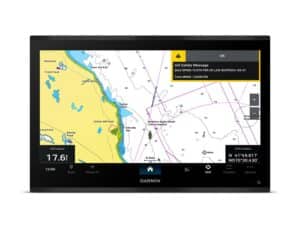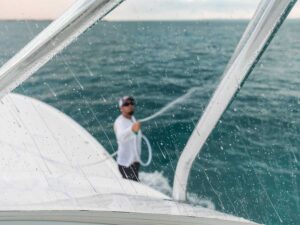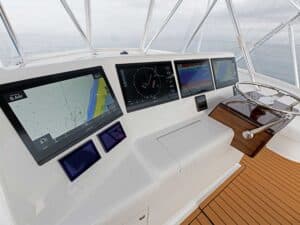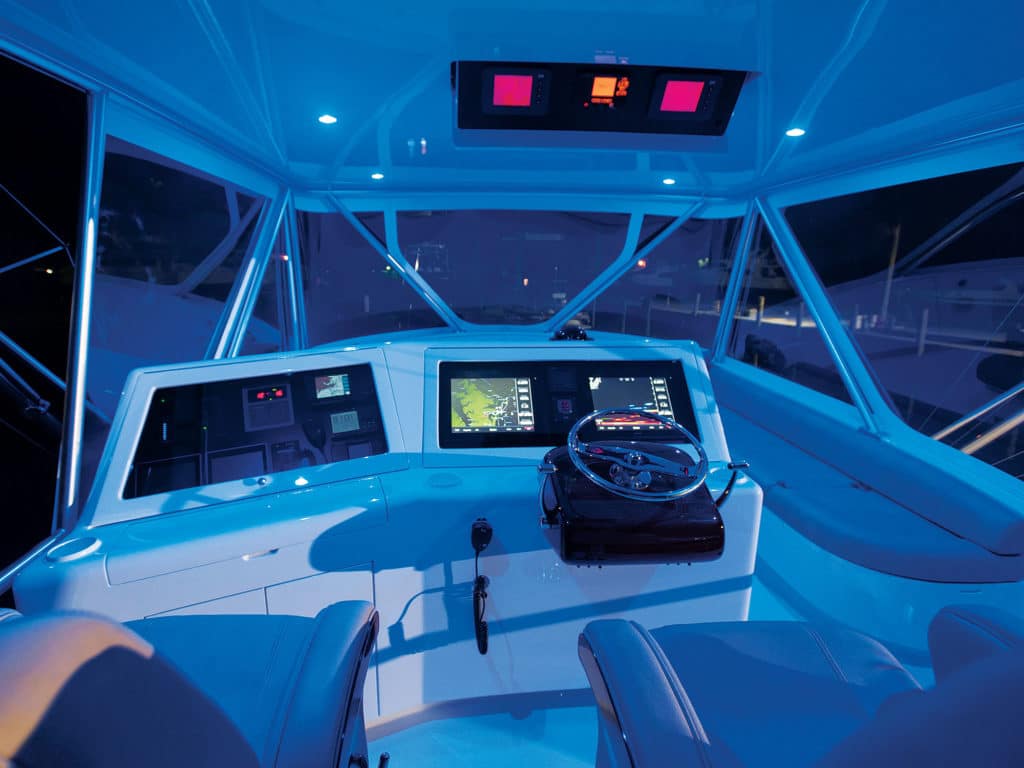
Not many moments beat heading back to the marina after a day offshore, your favorite song turned up in the background while you celebrate with the rest of your crew. And the global integration of audio controls through entire navigation suites via the NMEA 2000 backbone might not be the first thing that comes to mind in this scenario, but it sure makes everything easier and more enjoyable offshore.
This technology is not brand-new, but navigation-system manufacturers continue to partner with audio-system makers to develop more convenient operation of networking audio equipment. They’ve also built new mobile phone and tablet apps to control entertainment from anywhere on the boat, an attractive trend rapidly accelerating in the industry.
Industry Trends
Scott Gordy works for Offshore Marine in North Carolina. The company is the primary electronics installer for many custom-boat brands, including Jarrett Bay. His most requested brand of marine audio is Fusion. The reason is simple: It was the first to integrate seamlessly and easily into NMEA 2000 network backbones of Furuno, Garmin, Raymarine and Simrad navigation suites, and installers have the most experience with it. But Garmin and Simrad both offer proprietary black-box systems.
“We install Garmin about 90 percent of the time,“ Gordy says. “On sport-fishers like Jarrett Bay’s Builder’s Choice, we used Garmin GPSMap 8600 series glass helm displays, a GSD 26 chirp sounder and open array radar, and we networked Garmin’s Meteor 300 audio into that.
“I like to keep the installations simple,” he adds. “I also deal with a lot of skippers who are used to operating independent navigation and sonar equipment, and they want to keep those components.” On Builder’s Choice, the captain wanted to keep a Northstar 952X chart plotter from his previous boat and install a Simrad AP28 autopilot he was intimately familiar with.
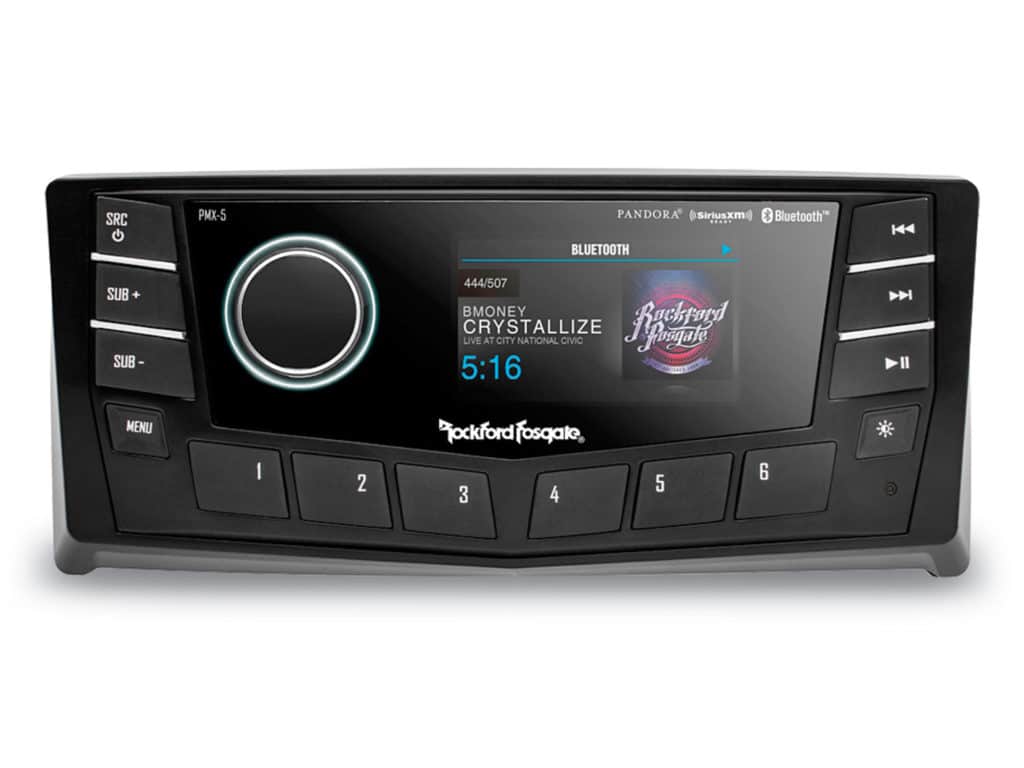
Gordy says installations of unrelated and non-networkable components is common in his field — except with audio. In that regard, integration is eagerly accepted, even expected. It gives the ability to choose music, as well as adjust volume and tone in the cockpit, helm deck and salon to any level. And it all happens via either the navigation displays, audio source or, perhaps most important, from anywhere on board with a mobile app.
There are two ways to integrate marine audio into a ship’s system, NMEA 2000 and a black-box system. Fusion was the first to open their codes to NMEA 2000 protocol, so installers are most familiar in its applications due to the large number of successful installations. But Rockford Fosgate, another top-shelf audio manufacturer, has partnered with FLIR Systems, makers of Raymarine navigation equipment, so connecting through Raymarine’s NMEA 2000 network is now a seamless plug-and-play event.
“We’re in a good place in marine audio,” says James McGowan of FLIR Systems. “We currently network with both Fusion and with Rockford Fosgate.”
The new partnership enables Raymarine to be the first to offer multiple third-party options for audio integration.
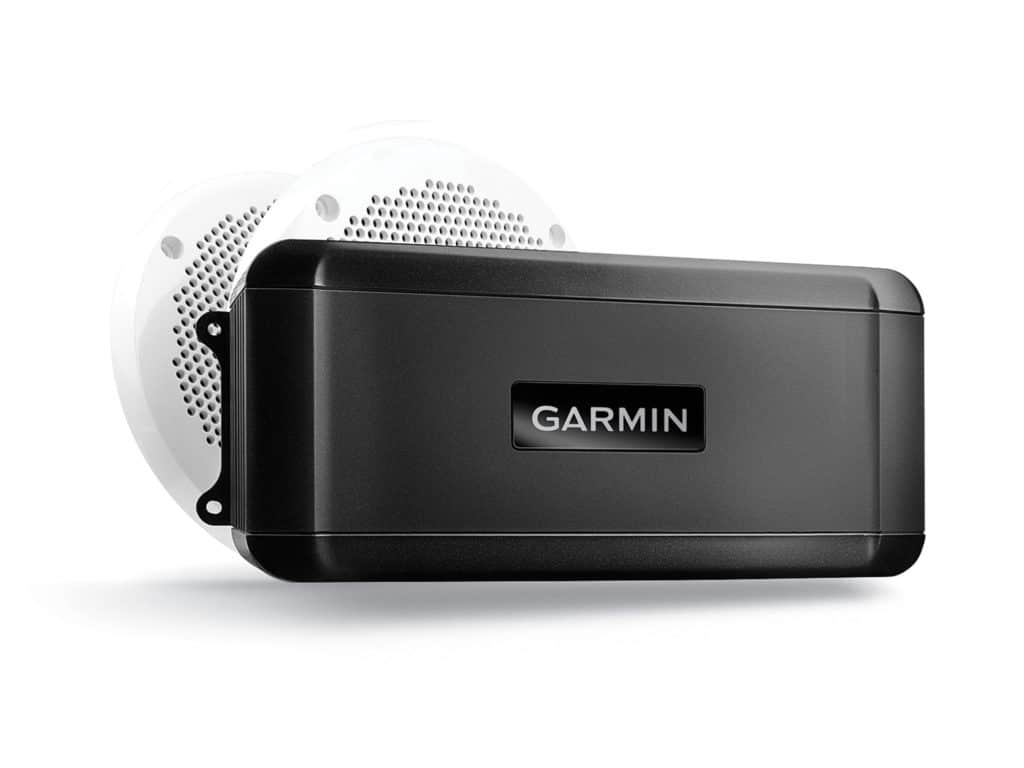
Black-Box Systems
Simrad and Garmin offer their own proprietary audio systems. Simrad has a great track record with their SonicHub system, and it allows individual control of multiple zones. Garmin recently introduced Meteor 300 with similar capabilities. Both black-box systems save real estate on the helm and below in addition to offering simple integration. Todd Tally, general manager of Atlantic Marine Electronics, usually opts for third-party audio on Vikings. The larger vessels offer the flexibility of more space on the helm to include a control head and various wired-network remotes. Tally likes that flexibility, and he saves the proprietary equipment for smaller vessels with more compact installations. On the other hand, Gordy chose the Garmin Meteor 300 for Builder’s Choice.
“We’re in a good place in marine audio. We currently network both with Fusion and with Rockford Fosgate.”
James McGowan, FLIR Systems
Satellite Entertainment
While it’s easy to get pretty wrapped up in audio systems, owners of sport-fishing boats look to installers for TV and Internet too.
On Builder’s Choice, Gordy was tasked to bring high-definition TV, Blu-ray, shore-based Wi-Fi and satellite Wi-Fi access to the vessel. To do so, he added a Denon AVR-X4100W receiver, Apple TV and a Sony BDP-s1500 Blu-ray player. He also installed a Vizio smart TV and a Samsung 6350 48-inch TV for satellite and streaming TV.
Both Tally and Gordy are in near lockstep agreement for satellite-TV reception. They use the KVH HD7 receiver for vessels over 65 feet and the HD5 for smaller vessels.

Beat Makers
For speakers, many lean toward JL Marine Audio, thanks to a long track record of high fidelity and reliability. However, Fusion added an entirely re-designed line of Fusion Signature speakers to their matrix this year, and, in words, the sound can best be described as delicious.
Insider Thoughts
I asked Gordy for any insider suggestions he had for better installations, and he offered two great ones.
First, every system he installs uses a battery backup, like those used with desktop computers to avoid a crash during power failure. He says the onboard systems are vulnerable to a changeover from vessel to shore power, and the battery backup protects them from shutting down or being damaged in that brief moment of power loss.
Second, and equally important, skippers and crew should be cognizant of where they are sourcing Internet access.
Smartphones automatically seek the best data stream available; once connected to satellite-based Internet via Wi-Fi, they’ll go back to it when shore-based or cellular connectivity fades. When that happens, the data bills can be shocking.
To read more, see the long list of electronics components installed on Jarrett Bay’s new 64-foot Builder’s Choice.

